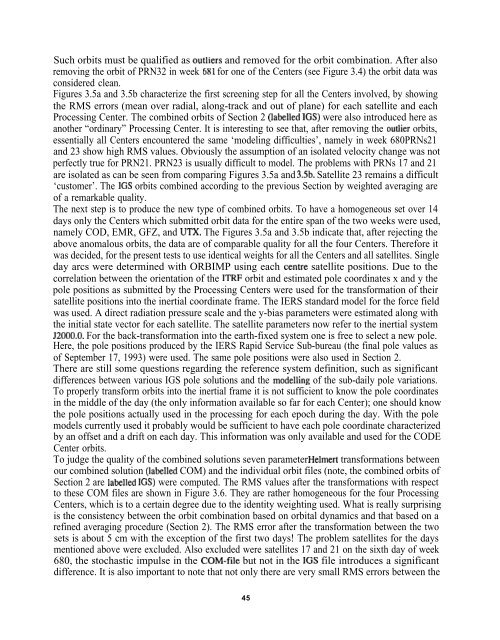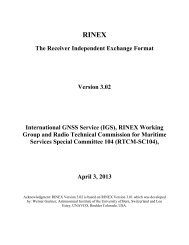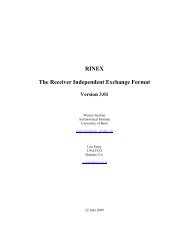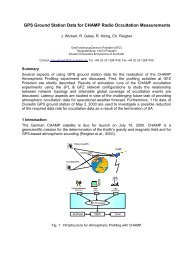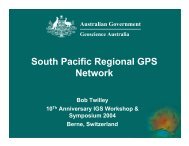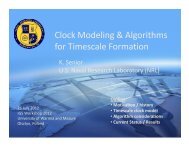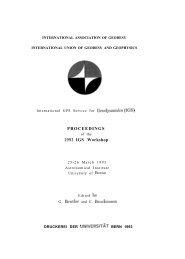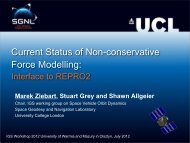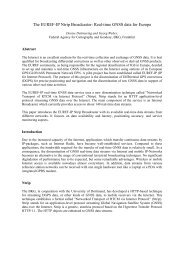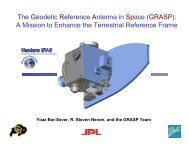IGS Analysis Center Workshop - IGS - NASA
IGS Analysis Center Workshop - IGS - NASA
IGS Analysis Center Workshop - IGS - NASA
Create successful ePaper yourself
Turn your PDF publications into a flip-book with our unique Google optimized e-Paper software.
Such orbits must be qualified as outliers and removed for the orbit combination. After alsoremoving the orbit of PRN32 in week 681 for one of the <strong>Center</strong>s (see Figure 3.4) the orbit data wasconsidered clean.Figures 3.5a and 3.5b characterize the first screening step for all the <strong>Center</strong>s involved, by showingthe RMS errors (mean over radial, along-track and out of plane) for each satellite and eachProcessing <strong>Center</strong>. The combined orbits of Section 2 (labelled <strong>IGS</strong>) were also introduced here asanother “ordinary” Processing <strong>Center</strong>. It is interesting to see that, after removing the outlier orbits,essentially all <strong>Center</strong>s encountered the same ‘modeling difficulties’, namely in week 680PRNs21and 23 show high RMS values. Obviously the assumption of an isolated velocity change was notperfectly true for PRN21. PRN23 is usually difficult to model. The problems with PRNs 17 and 21are isolated as can be seen from comparing Figures 3.5a and 3.5b. Satellite 23 remains a difficult‘customer’. The <strong>IGS</strong> orbits combined according to the previous Section by weighted averaging areof a remarkable quality.The next step is to produce the new type of combined orbits. To have a homogeneous set over 14days only the <strong>Center</strong>s which submitted orbit data for the entire span of the two weeks were used,namely COD, EMR, GFZ, and UTX. The Figures 3.5a and 3.5b indicate that, after rejecting theabove anomalous orbits, the data are of comparable quality for all the four <strong>Center</strong>s. Therefore itwas decided, for the present tests to use identical weights for all the <strong>Center</strong>s and all satellites. Singleday arcs were determined with ORBIMP using each centre satellite positions. Due to thecorrelation between the orientation of the ITRF orbit and estimated pole coordinates x and y thepole positions as submitted by the Processing <strong>Center</strong>s were used for the transformation of theirsatellite positions into the inertial coordinate frame. The IERS standard model for the force fieldwas used. A direct radiation pressure scale and the y-bias parameters were estimated along withthe initial state vector for each satellite. The satellite parameters now refer to the inertial systemJ2000.O. For the back-transformation into the earth-fixed system one is free to select a new pole.Here, the pole positions produced by the IERS Rapid Service Sub-bureau (the final pole values asof September 17, 1993) were used. The same pole positions were also used in Section 2.There are still some questions regarding the reference system definition, such as significantdifferences between various <strong>IGS</strong> pole solutions and the modelling of the sub-daily pole variations.To properly transform orbits into the inertial frame it is not sufficient to know the pole coordinatesin the middle of the day (the only information available so far for each <strong>Center</strong>); one should knowthe pole positions actually used in the processing for each epoch during the day. With the polemodels currently used it probably would be sufficient to have each pole coordinate characterizedby an offset and a drift on each day. This information was only available and used for the CODE<strong>Center</strong> orbits.To judge the quality of the combined solutions seven parameter Helmert transformations betweenour combined solution (labelled COM) and the individual orbit files (note, the combined orbits ofSection 2 are labelled <strong>IGS</strong>) were computed. The RMS values after the transformations with respectto these COM files are shown in Figure 3.6. They are rather homogeneous for the four Processing<strong>Center</strong>s, which is to a certain degree due to the identity weighting used. What is really surprisingis the consistency between the orbit combination based on orbital dynamics and that based on arefined averaging procedure (Section 2). The RMS error after the transformation between the twosets is about 5 cm with the exception of the first two days! The problem satellites for the daysmentioned above were excluded. Also excluded were satellites 17 and 21 on the sixth day of week680, the stochastic impulse in the COM-file but not in the <strong>IGS</strong> file introduces a significantdifference. It is also important to note that not only there are very small RMS errors between the45


